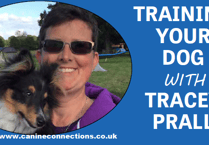This year seems to be flying by and it’s true what they say, as you get older, time goes quicker! I had a lovely session with a young pup this week and it reminded me of how less is more when we are training and helping our pup understand new things. We
really don’t need to spend ages on a training session with our new pup. In fact, it is far more effective to train your pup for no longer than two minutes at a time. (This is also useful for teenage dogs or older dogs too) This prevents boredom and helps prevent the possibility of the pup becoming distracted and switching off.
A pup’s attention span is very limited and they are taking in so much information at any one time, for them to concentrate on one thing takes a lot of effort. When I run classes, the approximate time they run for is 45 minutes. This enables me and my wonderful helper to advise, give help and enough focus and attention on each individual pup and handler.
Our goal is to give you the tools to go away and practice what you have been taught with your pup in your own time-there’s lots of homework suggestions. In class we give our pups a lot of breaks as they need frequent down time to recover from learning new stuff.
So, when you are at home, the best advice is to keep the training sessions short and sweet. Keep a big box of prepared training treats ready in the fridge and access them when you have a couple of minutes to do some training. It can be really helpful to set a timer before you start training so you don’t get carried away and do too long!
So, where do we find those couple of minutes? Here are some suggestions along with exercises you could practice in the time:
- While the kettle is boiling for a cuppa: sit/down/mini stay
- Having a shower: settle on a bed/stay/focus on an enrichment toy/puzzle in the same room or another place.
- Getting dressed: settle on bed/mini stay/focus on a chew or snuffle mat in a different room.
- Having a quick snack at the table: sit/down/settle on bed with a chew
- Popping to the local shop: loose lead walking/find it game/stay/wait and recall.
- Going out to feed the chickens /cat/other animals: loose lead walking/find a scatter of treats, remaining calm while other animal is getting attention.
- Chatting to a neighbour at the gate: sit, calm behaviour/say hi politely/food scatter to keep busy and calm.
- Opening the door to the post person or delivery person: either sit, calm behaviour for greeting/or settling on bed or mat indoors with treats of snuffle mat while door opens.9/Walking around the garden: loose lead walking/ wait/ recall/stay.
- Walking to the post box just up the road: loose lead walking/walking calmly with treats past distractions.
I think we often put a lot of expectation on our pups to learn everything and we need to ‘drill’ them. The opposite of this is much better for learning. Fun sessions, two minutes at a time and stop before pup gets too tired or bored. Remember not to put too much expectation on yourself too.
At the end of the day, if you manage two, two-minute session every day, that’s brilliant, remember also that they are watching you all the time (when not asleep) and learning about you and your day, what makes the household tick. Keep treats in your pocket so that if you see pup offering a great behaviour, reward it. If you can make it a short fun training session, it will deepen your connection with your pup.However much training you manage to fit into your day, remember to simply enjoy your pup, they grow up all too quickly





Comments
This article has no comments yet. Be the first to leave a comment.